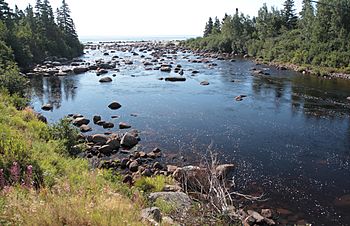Trinité River facts for kids
Quick facts for kids Trinité River |
|
|---|---|

Mouth of the river
|
|
| Native name | Rivière de la Trinité |
| Country | Canada |
| Province | Quebec |
| Region | Côte-Nord |
| RCM | Manicouagan, Sept-Rivières |
| Physical characteristics | |
| River mouth | Baie-Trinité 0 metres (0 ft) 49°25′05″N 67°18′09″W / 49.418167°N 67.302542°W |
| Basin features | |
| River system | Gulf of Saint Lawrence |
The Trinité River (French: Rivière de la Trinité), or Grande Trinité River is a river in the Côte-Nord region of Quebec, Canada. Salmon fishing is allowed, subject to limits.
Contents
Course
The Trinité River is in Baie-Trinité, Manicouagan, Quebec. It is 75 kilometres (47 mi) long. The river runs through a winding valley in the Canadian Shield before entering the Gulf of Saint Lawrence beside the village of Baie-Trinité. There are a few small lakes in the northern, Sept-Rivieres part of the river basin, including Lac Washamahwun, Lac Lanctot, Lac Rimouski and Lac Fox. The river flows slowly through 67 shallow fishing holes interspersed with large rocks, with a steeper section near the end where it runs faster. The river is accessible from Quebec Route 138.
Environment
A map of the Ecological regions of Quebec shows the upper portion of the river rising and flowing south through the eastern spruce/moss domain of the boreal zone. Most of the river flows through the fir/white birch domain of the boreal zone. The average annual temperature in the region is 0 °C (32 °F). The warmest month is August, when the average temperature is 16 °C (61 °F), and the coldest is February, with −19 °C (−2 °F).
Dam
Salmon use the fish ladder at the Grande Trinité River dam to reach the upper part of the river. This was an old wooden structure built in 1929. It collapsed in May 2009 and a CDN$4.5 million project was started to build a replacement concrete structure. As part of the process cofferdams were built upstream and downstream. The fish could still pass, but fishing was disrupted.
Fishing
Most of the river is managed for recreational fishing by the Zec de la Rivière-de-la-Trinité, which provides campsites, cabins an boat rentals. Every year 700 to 800 salmon return. The healthy salmon population is an important attraction to visitors. There are also sea trout. The fishing season is from June to mid-September.
Management regimes
The Saint-Lawrence Paper company held the exclusive fishing rights to the Grande Trinité and Petite Trinité rivers from the 1930s until the early 1960s, when it sold them to Domtar. The river was used by wealthy Domtar executives and their guests until May 1976, when it was released to the non-profit Baie-Trinité Development Corporation in May 1976 in response to pressure from the people of Baie-Trinité.
In 1978 the Baie-Trinité fishing and hunting reserve was created to cover the 356 kilometres (221 mi) of territory between the existing Rivière-Trinité and Petite-Trinité reserves. The Rivière-Trinité reserve became the Zone d'exploitation controlée (Zec) Rivière de la Trinité. In 1982 the Grande Trinité River was considered a representative salmon river of the upper Côte-Nord, and became an "experimental river" where researchers began to study salmon.


